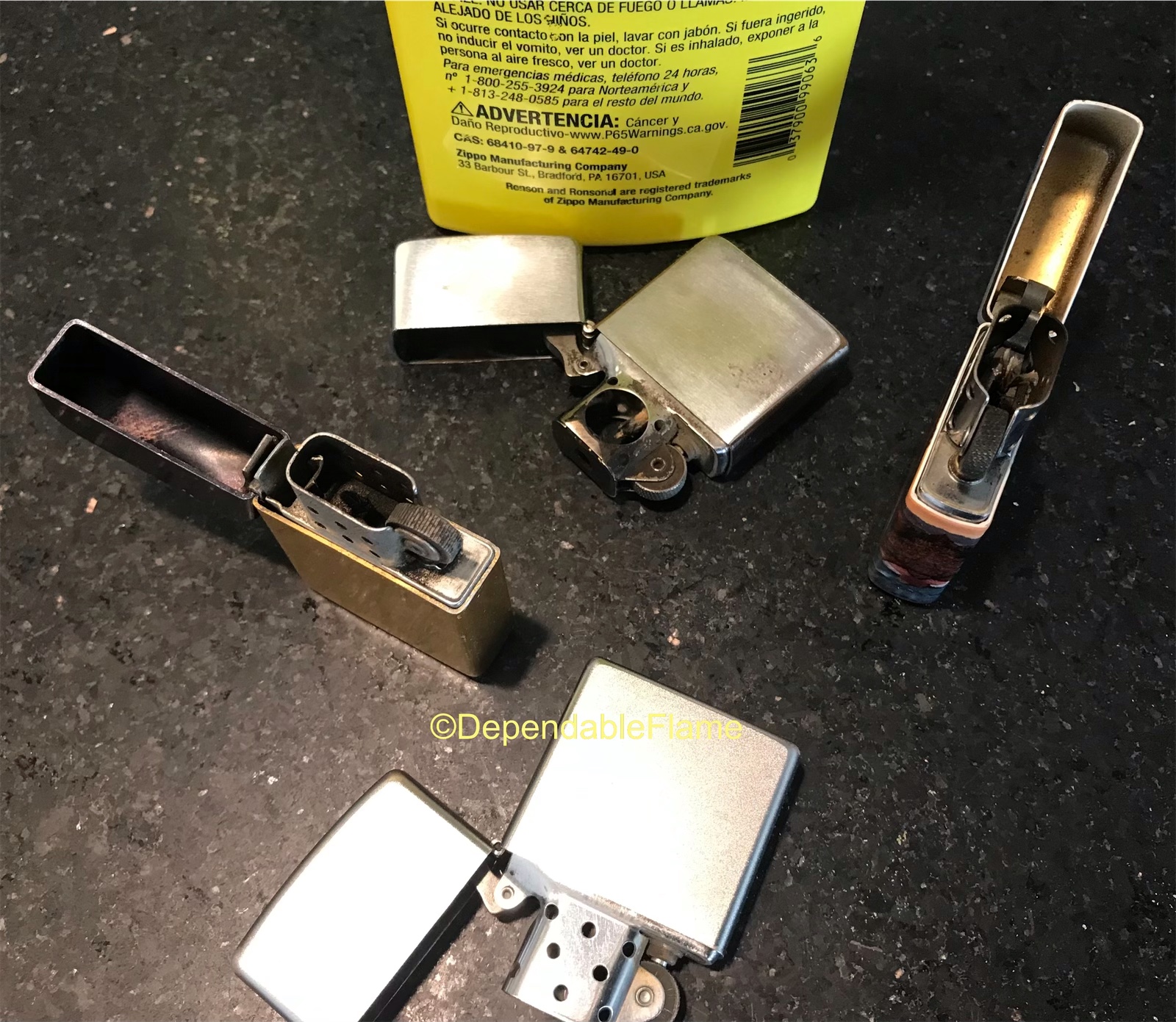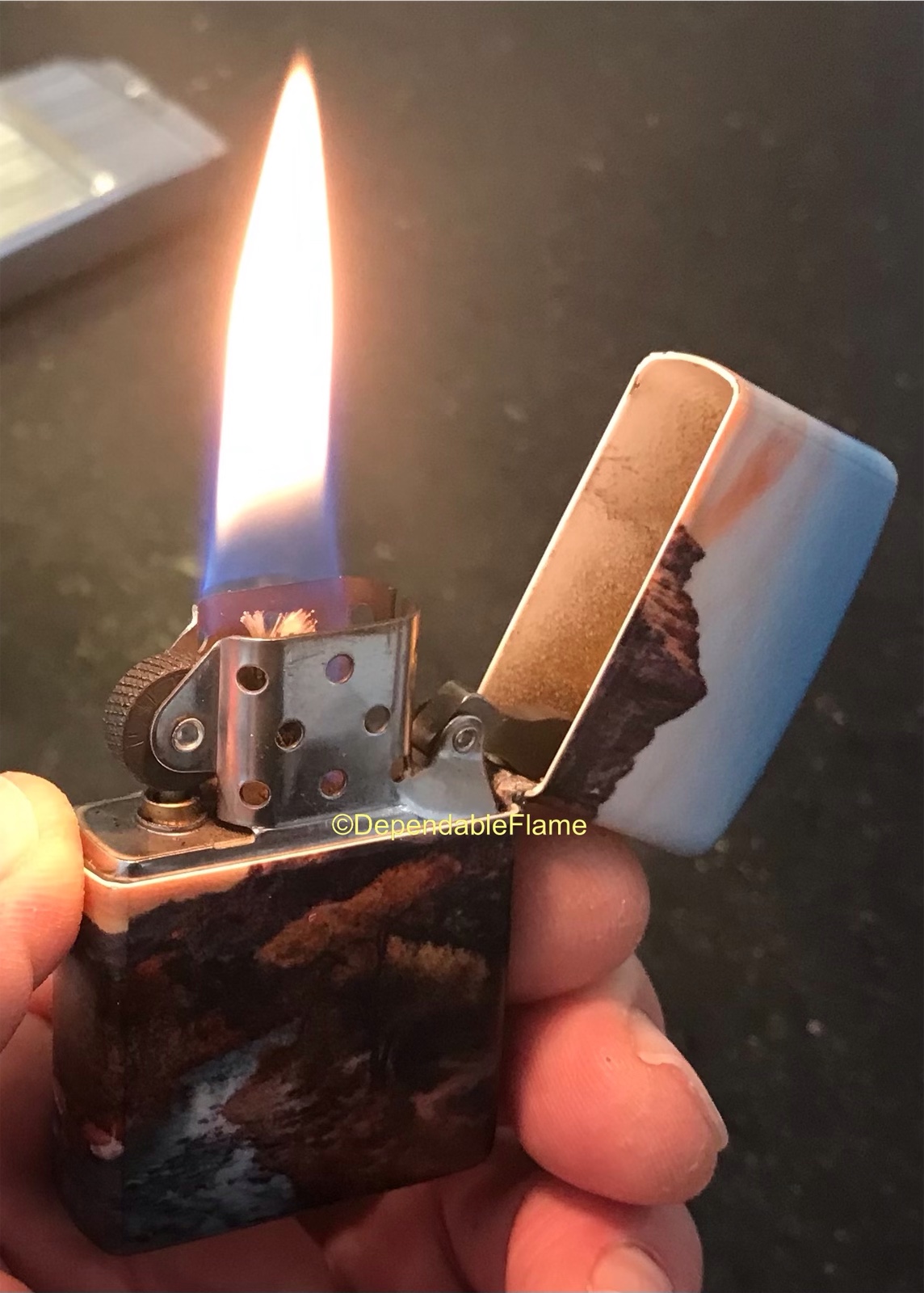Sometimes it seems you have done everything necessary to get your vintage petrol lighter back up and running but for some mysterious reason the thing just won’t manage to light! Take heart, your frustration may be only a few fans of the hand or a mouthful of breath or two from being over!
What Is Needed
In order to successfully produce fire, any petrol lighter is going to need three elements to be present: the lighter has to be fueled for the wick to sustain a flame, a spark must be present to ignite it and oxygen must be available to feed it. Take any of these elements out of the equation and a flame will not be made.
available to feed it. Take any of these elements out of the equation and a flame will not be made.
Sometimes though, even with all three prerequisites present, achieving a flame still remains elusive. An inexperienced lighter mechanic could easily get frustrated, curse the lighter and even give up.
That fate befell me many times early on as ignorance met my haste to get the lighter running now and I ended up feeling defeated, even if only temporarily.
What We Have Here
Have you ever spun the wheel on your freshly fueled Zippo over and over to the point that one might think it had no fuel at all? Perhaps you have pressed the thumb lever on a Ronson Standard repeatedly only to watch a small explosion occur just above the wick and then disappear just as quickly, never actually catching the wick? Or any other petrol lighter you’ve had to strike so many times before it finally caught that you were about to give up, only to find yourself repeating the same futile feeling cycle moments later when needing a light?
Vapor lock is caused by a dearth of available oxygen, having usually been choked or flooded out by an excess of petrol fuel. This can prevent your wick from catching flame as the excess fuel sort of blows the necessary chemical reaction out of the ignition area, sometimes appearing as a small explosion. Other times, it simply acts like there is no fuel.
All of the situations described above could be typical symptoms of vapor lock. Zippo, Ronson, Evans and pretty much any other lighter you could lay your hands on can be prone to under the right(or should I say wrong?) circumstances.
Even my beloved Penguin Cygnus roller lighters which I have publicly stated are impervious to the condition can fall prey. Every time it’s happened to me with a Cygnus though, I believe the flint tension adjustment to be just as much the culprit as vapor lock seeing how a roll of the thumb roller tightening the flint tension intensified the spark produced and thus curing the problem.
Some Things That May Contribute
The fit of your wick inside the chimney, looseness especially, can play a role in allowing too much fuel vapor to flood the ignition area. A wick wet with fuel is not ideal for catching flame. Petrol lighters are designed to run off the vapor, not burning the liquid fuel directly.
to run off the vapor, not burning the liquid fuel directly.
A perfect fitting wick can fall victim as well though as over-filling any petrol lighter will cause it to leak out of the wick. I received a question on a YouTube video earlier in the week where a viewer asked if fueling his Zippo and it dripping a couple drops out the top of the wick was over-filling it? My answer was yes but only slightly yet that is still sufficient to cause vapor lock.
Windscreens often play a major role in a lighter succumbing to vapor lock. Windscreens are designed to keep too much wind out, thus protecting the flame but they can also hold vapor in thereby choking out any available oxygen which is the very definition of vapor lock.
Proximity of the wick in relation to the file wheel and resulting spark may also play a role. Really just about any petrol lighter setup with a deficiency of oxygen and or surplus of fuel vapor is going to be prone but other factors may exacerbate your situation.
How To Fix It
I have seen old Zippo pamphlets that give instructions on how to cure a lighter of vapor lock. It seems that the illustrations ran contrary to the actual instructions but the gist of it was to run the lighter up into the air, forcing excess fuel vapor out of the ignition area. Moving your lighter downward may have the same effect though, basically either direction could have a “fanning” effect on the chimney or ignition area.
Another effective remedy is to simply blow air into the ignition area. I’m talking about your own breath, just a gust or two are all that’s usually required.
Air shot from a compressor is typically not warranted but if your lighter is grossly over-fueled it could solve your problem faster. It doesn’t take long for exposed fuel to evaporate but when the lighter has way too much inside, the compressed air can force it out quickly thus getting your lighter dryer faster.
Letting the lighter set with the snuffer or lid open should also do the trick. Maybe not quick enough for some but it’ll eventually get there.
Fueling the lighter properly will keep you from ever getting vapor lock in the first place. This may sound really simple to avoid but can be more difficult than you think. There is an art to fueling a lighter perfectly, too little and you get no flame, too much and the flame blows out the top of the chimney.
Keep Everything Running Smooth
It may be easier said than done but a properly fueled lighter should never suffer from vapor lock. This is coming from someone who has habitually and constantly over-filled lighters with fuel, perhaps the reason I am so familiar with vapor lock!
reason I am so familiar with vapor lock!
It is therefore good practice to get proficient at fueling your lighter with the proper amount of petrol. Again, some lighters are more prone to vapor lock than others but it’s a condition that can easily befall any of them.
If you enjoy working on, collecting or talking about old cigarette lighters, check out the DependableFlame.com YouTube channel. We publish regular show and tell videos for the lighters we sell and instructional repair demonstration videos for many of them as well. There is a tremendous community of like-minded folks who are just waiting there to experience the camaraderie of the hobby along with you and us!
We do a live stream most Tuesday mornings called Coffee And Lighters Live! Please check out the archives of those streams anytime and plan to join us live on Tuesday for the next one.
Please leave any comments or questions at the bottom of this or any other article on DependableFlame.com. I would love to converse with you and the comments section on this site is now the only place that I answer questions about repairing vintage petrol lighters.
Until next time…✌️
Alright folks, gather around and let’s talk about vapor lock in vintage petrol lighters. Now, I don’t know about you, but I love a good vintage lighter. There’s something special about that classic look and feel that just can’t be matched by modern lighters. But as with any old piece of machinery, sometimes things can go wrong, and that’s where vapor lock comes in.
For those of you who don’t know, vapor lock is when the fuel in your lighter gets trapped in the fuel chamber and can’t make it to the wick. This can be caused by a number of factors, including high altitude, low fuel pressure, or even just a clogged fuel line. But don’t worry, the good folks over at Dependable Flame have got you covered with their handy guide on how to fix it.
The article goes through step by step on how to diagnose and fix vapor lock in your vintage lighter, and even includes helpful pictures to guide you along the way. As someone who’s had their fair share of issues with vintage lighters, I can tell you that this guide is a real lifesaver.
So, to the author of this article, I say thank you. Your knowledge and expertise in the world of vintage lighters is truly appreciated. And to all of you out there with vintage lighters of your own, don’t hesitate to give this guide a read. Your lighter will thank you for it.
Thank you Bob for such an enthusiastic recommendation, I am pleased that you enjoyed the article and refer it to others. It is a hot for me to write these articles but even more so to see folks use them to get their lighters functioning properly and to know the comment is helpful. So thank you again for helping me to be more helpful!✌️
Hi Joseph,
What an interesting collection of content you have here- taming the fire! Wow.
I can tell you that ultimately I throw away the lighter in complete frustration while attempting to repair. Now your article has given me motivation to actually repair it.
The vapour lock is an interesting piece for me to know. Can keeping the fuel pressed for sometime and then attempting to re-light it help in this case?
Very interesting article. Waiting for more to come.
Regards,
Rohit
Hello Rohit, I am very glad you found us! If you typically throw your lighters away, then there is plenty of info here nor only to convince your otherwise but also give you common steps to take to be more efficient in your use of cigarette lighters. To answer your question about relighting a petrol lighter suffering from vapor lock, the only thing that will improve the situation is one way or another to disperse the excess fuel vapor that had gathered around the ignition area.✌️
With Vintage lighters, it is often challenging on finding a reputable source of information about repair options! I am glad you are offering your insights and expertise for those who may still have in their possession one of these fine marks of history, and that there is a community available for those who enjoy having these products in their possession. Owning your own metal lighter was always an investment, and an indication of higher social status in the area where I grew up. There was a saying I heard long ago, and that you could tell a lot about a man in the type of lighter that he carried! Have a great week!
Thank you Angela, I appreciate you stopping by again! When I started down this road, it was very difficult to find information. That’s one of the main reasons I decided to create this site and to document all the lighters that cross through my hands, so that at least this info would be established for the next person that came along. There’s a lot of cool mechanisms and gadgets out there that time seems to have forgotten and I enjoy all the work of getting them back in working order.